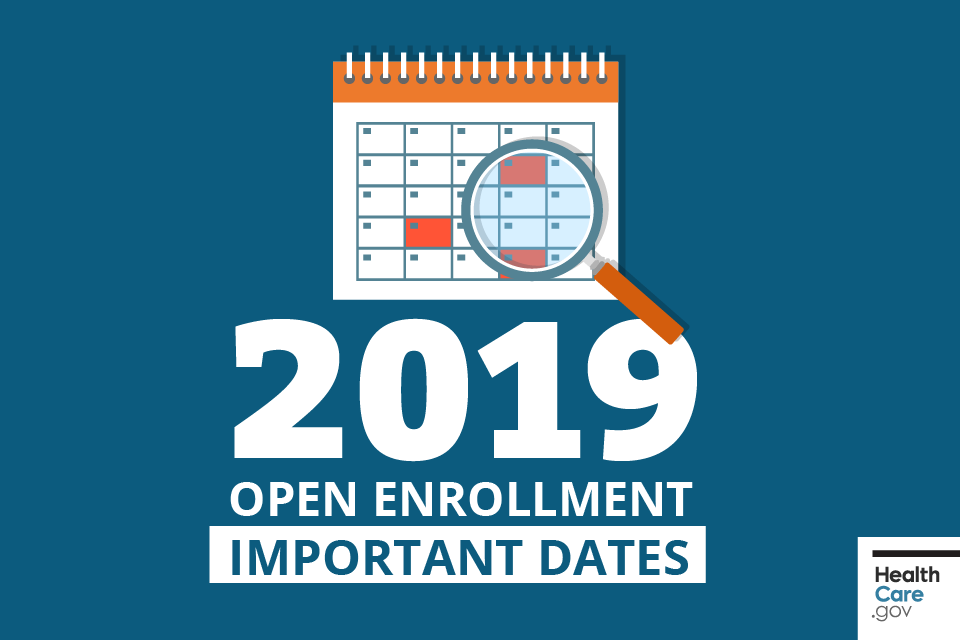When is Medicare Open Enrollment?
Louise Norris
April 19, 2019
Medicare open enrollment dates
The annual Medicare open enrollment period is from October 15 to December 7.
NEW as of 2019: Medicare Advantage open enrollment (January – March)
Medicare changes for 2020
Q: When is Medicare Open Enrollment?
A: The annual Medicare Open Enrollment period begins on October 15 and continues until December 7. For 2020 coverage, open enrollment will run from October 15, 2019, to December 7, 2019.
During the annual enrollment period (AEP) you can make changes to various aspects of your coverage.
You can switch from Original Medicare to Medicare Advantage, or vice versa.
You can also switch from one Medicare Advantage plan to another, or from one Medicare Part D (prescription drug) plan to another.
And if you didn’t enroll in a Medicare Part D plan when you were first eligible, you can do so during the general open enrollment, although a late enrollment penalty may apply.
If you want to enroll in a Medicare Advantage plan, you must meet some basic criteria.
You must be enrolled in Medicare Part A and B.
You must live in the plan’s service area.
You cannot have End-Stage Renal Disease (some exceptions apply; ESRD patients will be able to enroll in Medicare Advantage plans as of 2021, under the terms of the 21st Century Cures Act).
Is auto-renewal available?
If you’re already enrolled in a Medicare Part D prescription plan or a Medicare Advantage Plan and you don’t want to make changes to your coverage for the coming year, you don’t need to do anything during open enrollment, assuming your current plan will continue to be available. If your plan is being discontinued and isn’t eligible for renewal, you will receive a non-renewal notice from your carrier prior to open enrollment. If you don’t, it means you can keep your plan without doing anything during open enrollment.
But be aware that your benefits and premium could change from one year to the next. So even if you’re confident that you want to keep your current coverage for next year, it’s important to make sure you understand any changes that may apply, and that you’ve double checked to make sure that your current plan is still the best available option. The available plans and what they cover changes from one year to the next, so even if the plan you have now was the best option when you shopped last year, it’s important to verify that again before you lock yourself in for another year.
Changing Medicare Advantage coverage after the annual enrollment period
Between January 1 and March 31 each year, if you are enrolled in a Medicare Advantage plan, you can leave your plan and return to Original Medicare, and buy a Part D prescription drug plan to supplement your Original Medicare. As of in 2019, you also have the option to switch to a different Medicare Advantage plan during this time. From 2011 through 2018, there wasn’t an option to switch to a different Medicare Advantage plan outside of the fall open enrollment period unless you had a circumstance that allowed you a Special Enrollment Period. But the 21st Century Cures Act (Section 17005) expanded the timeframe of the window (from one and a half months to three months) starting in 2019, and allows people to switch from one Medicare Advantage plan to another.
Only one switch during this time frame is allowed each year — you can change your mind multiple times during the enrollment period in the fall, but can only switch to a different Medicare Advantage plan (or back to Original Medicare) once in the first quarter of the new year. But if you sign up for a Medicare Advantage plan in the fall and then decide you don’t like it once it takes effect in January, you have until the end of March to make a change.
You can only sign up for Part D coverage during the first three months of the year if you’re switching from a Medicare Advantage plan back to Original Medicare. You cannot, for example, be enrolled in Original Medicare with a Part D plan and then switch to a different Part D plan during the January — March enrollment period. Instead, you’d need to make that change during the fall election period (October 15 to December 7).
Enrolling in Original Medicare
If you didn’t sign up for Medicare A and B when you were first eligible, you have a chance to do so each year from January 1 to March 31, with coverage effective July 1. You may be subject to a late enrollment penalty, however. For Medicare Part B, the penalty is an additional 10 percent of the premium for each 12 month period that you were eligible but not enrolled.
There’s a late enrollment penalty for Medicare Part A as well, but it only applies to people who have to pay premiums for Part A. Most people get Part A for free, based on their work history (or a spouse’s work history).
2020 Medicare coverage changes
Medigap plans that cover the Part B deductible will no longer be available for purchase by newly-eligible Medicare beneficiaries. Medigap plans C and F. This rule change was part of MACRA (the Medicare Access and CHIP Reauthorization Act of 2015), and it was made because politicians felt that imposing the Part B deductible on all enrollees would help to avoid over-utilization of health care. When a person has Medigap Plan C or Plan F, they can receive all Part B services without any out-of-pocket costs. But if they have a Medigap plan that doesn’t cover the Part B deductible, they have to pay at least $185 for Part B services in 2019 (the Part B deductible increases over time, but it’s much smaller than the deductible under Part A, which can continue to be covered under Medigap plans sold to new enrollees in 2020 and beyond). People who already have Medigap Plans C and F will be able to keep them, and people who are already eligible for Medicare prior to 2020 will still be able to buy those plans. But for newly-eligible enrollees, Plan C and Plan F will be discontinued after the end of 2019.
The donut hole is being eliminated in 2020 for generic drugs. (It was eliminated one year ahead of schedule, in 2019, for brand-name drugs). The gap in prescription drug coverage (the donut hole) starts when someone reaches the initial coverage limit ($3,820 in 2019), and ends when they have spent $5,100 (these thresholds are each slightly higher than they were in 2018). Prior to 2011, Medicare Part D enrollees paid the full cost of their medications while in the donut hole. But the ACA has been steadily closing the donut hole, and it will be fully closed by 2020, when enrollees in standard Part D plans will pay just 25 percent of the cost of their drugs all the way up to the catastrophic coverage threshold (insurers have the option to offer plans with lower cost-sharing, and many do). But the Bipartisan Budget Act of 2018 (BBA 2018) closed the donut hole one year early for brand name drugs. As a result of the BBA, enrollees’ out-of-pocket costs for brand-name drugs are limited to 25 percent of the cost in 2019 (down from the 30 percent that was originally scheduled) and 37 percent of the cost of generic drugs (down from 44 percent in 2018). The cost of closing the donut hole one year early for brand-name drugs was shifted onto drug manufactures. The donut hole will also close for generic drugs in 2020, when enrollees will pay no more than 25 percent of the cost of generics. The Medicare Part D maximum deductible will be $435 in 2020, up from $415 in 2019 (it increases each year).
Medicare Advantage plans will continue to see changes. Medicare Advantage plans continue to gain in popularity. 34 percent of Medicare recipients were enrolled in a Medicare Advantage plan in 2018—a significant increase from the enrollment total in 2010 when the ACA was signed into law (as of early 2019, CMS reports that about 37 percent of Medicare beneficiaries have private coverage instead of Original Medicare; virtually all of those enrollees have Medicare Advantage, although a very small fraction have Medicare Cost Plans). Most people continue to have numerous Medicare Advantage plans as well as Part D plans available to them. However, these providers can change the coverage options they offer from year to year so it’s important to stay up-to-date.
Changes that took effect in 2019:
There’s a new premium bracket for the highest-income Part B and Part D enrollees. Under the terms of the Bipartisan Budget Act of 2018, enrollees with an income of $500,000 or more ($750,000 or more for a married couple) will pay a new, higher premium for Part B and Part D coverage in 2019 and future years. For reference, in 2018, the highest income bracket starts at $160,000 ($320,000 for a married couple). The Medicare Trustees’ report projected a Part B premium of $460.70/month for Part B enrollees in the new highest bracket in 2019, and an additional $82.90/month added to the Part D premiums charged by the insurer that provides the Part D coverage.
Medicare Part B premiums increased slightly. Medicare Part B premiums increased to $135.50/month for most enrollees, and that’s the amount that most enrollees are actually paying in 2019. For perspective, in 2017, most Medicare Part B enrollees paid an average of $109/month for their Part B premium, although enrollees with income above $85,000 had higher premiums. But the standard premium for Medicare Part B was $134/month in 2017. The reason most enrollees paid an average of only $109/month was that the cost of living adjustment (COLA) for Social Security wasn’t large enough to cover the full increase in Part B premiums. For 70 percent of Part B enrollees, their premiums are deducted from their Social Security checks, and net Social Security checks cannot decrease from one year to the next (the “hold harmless” provision). The COLA for 2017 was only enough to cover about four dollars in additional Part B premiums, so the $134/month premium for 2017 only applied to enrollees to whom the “hold harmless” provision didn’t apply. The COLA for 2018 was larger, but still not quite high enough to cover the full increase to $134/month for all enrollees. People who were “held harmless” paid an average of $130/month for Part B in 2018, while the standard premium remained at $134/month. So while there was still a small difference between what people paid in Part B depending on whether they were “held harmless,” the difference was not as stark as it was in 2016 and 2017; the difference had mostly leveled out for 2018 (except those with high incomes, who always pay more). For 2019, the Social Security COLA was more than enough to cover the increase in Part B premiums, which amounted to an average of $5.50/month (from the $130/month average that most enrollees were paying in 2018, to the standard $135.50/month 2019 premium). So most enrollees are paying $135.50/month in 2019, although those with high incomes always pay more, and Medicaid covers Part B premiums for some low-income enrollees, regardless of what the standard premium is.
Each year, most Medicare beneficiaries should receive their Annual Notice of Change (ANOC) and Evidence of Coverage (EOC) from their existing Medicare Advantage and Medicare Part D plan providers by Sept. 30. CMS makes information available to the public on Medicare.gov in October. The Medicare website is also a tremendous asset for individuals with questions about Medicare rules, timelines, Medicare Part D, etc.
It’s important to carefully review the information sent to you by your plan provider, since this will cover any possible changes. For example, increasing co-pays, changes to drug formularies or changes to treatment coverage. Once open enrollment gets underway, you can make changes that reflect your current health coverage needs.
Louise Norris is an individual health insurance broker who has been writing about health insurance and health reform since 2006. She has written dozens of opinions and educational pieces about the Affordable Care Act for healthinsurance.org. Her state health exchange updates are regularly cited by media who cover health reform and by other health insurance experts.
Related terms
Medicare Advantage
Medicare open enrollment
Medicare Part D
prescription drug coverage
Related topics
How do I enroll in Medicare?
Medicare Advantage enrollment
Important enrollment dates
Tags: Medicare Advantage, Medicare open enrollment, Medicare Part C, Medicare Part D, prescription drug coverage






